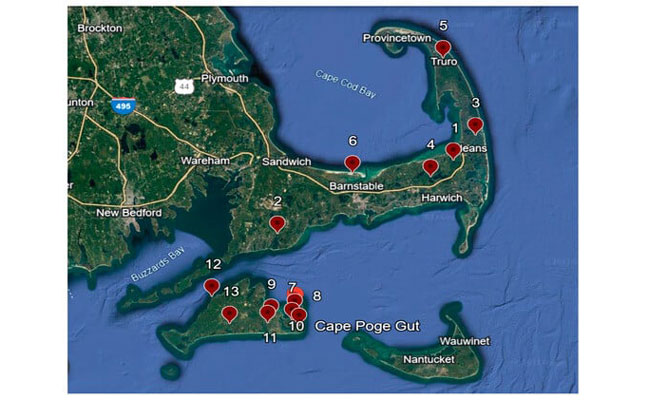Researchers at the New England Regional Center of Vector-Borne Diseases (NEWVEC) at the University of Massachusetts Amherst have come up with a new and more accurate method for detecting in ticks carrying the emerging Powassan virus, which can cause life-threatening neuroinvasive disease, including encephalitis and meningitis.
This new approach reduces the incidence of false positive test results, the NEWVEC researchers found. The team describes the study, titled “Tick-borne Viruses: Transmission and Surveillance,” in the journal Viruses.

Tick collection sites along coastal mainland and islands of Massachusetts. IMAGE: VIRUSES
“Powassan has been a growing concern in New England for the past several years and false positives can confound efforts to surveil,” Dr. Stephen Rich, professor of microbiology at UMass Amherst and principal investigator and executive director of NEWVEC, told Medical Xpress. “The development of sensitive detection methods for diagnostics and surveillance is critical.”
Named after the town in Ontario, Canada, where it was first identified in 1958 in a 5-year-old boy who died from encephalitis, Powassan virus is a flavivirus related to West Nile and other mosquito-borne viruses.
Though still rare, Powassan virus is drastically increasing in incidence in the U.S., predominantly in the Northeast and Great Lakes regions. More than 10 percent of the record 290 U.S. cases reported in 2022 (compared to only one case per year from 2004 to 2006) resulted in death, and half of the survivors suffered long-term neurological damage. The virus is transmitted to humans primarily by black-legged ticks (Ixodes scapularis), also known as deer ticks, which are known carriers of Lyme disease, babesiosis and other tick-borne illnesses.
The team at NEWVEC — which brings together academic communities, public health practitioners and residents and visitors across the Northeast in an effort to reduce diseases spread by ticks and mosquitoes — developed a triplex real-time polymerase chain reaction (PCR) test for both the Powassan virus and Powassan virus lineage II (known as deer tick virus) in Ixodes scapularis. The prototype Powassan virus is found mostly in groundhog ticks (I. cookei) and squirrel ticks (I. marxi), two species that rarely bite humans or human pets.
The NEWVEC team conducted a tick survey in coastal and offshore Massachusetts, focusing on 13 sites from the highly endemic regions of tick-borne diseases in Cape Cod and Martha’s Vineyard. They tested the ticks for Powassan virus, comparing their new triplex PCR method to the standard, commercially available Luminex xMap technology.
“The good news is that ours works as well as the other one. So, in other words, everything that the other one could detect, we could detect,” Dr. Rich said. “The great news is that we also overcame the problem of false negatives, which is what happens when a sample is not of sufficient quality that any test would ever be able to detect the virus in it.”
The new triplex method accomplishes a reduction in false negatives by using a “clever” quality control. Both tests seek to detect the presence of Powassan virus RNA.
“But we also had a paired search for the RNA from the tick, which is present in every tick regardless of whether it has the virus or not,” Dr. Rich said. “And what that tells us is if we can amplify tick RNA, then we have some hope of being able to detect the virus RNA. If we don’t detect the tick DNA, then we have no hope of being able to detect the virus RNA.
Dr. Rich explained that before they developed that method, people would be left to wonder whether a negative result meant that the virus wasn’t there or that the sample wasn’t testable.
“So, we’ve ruled out that latter possibility. And now we know with some assurance that when a tick tests negative, it’s a true negative. It’s not that the sample just isn’t good enough. We found pockets of high incidence of this virus,” Dr. Rich said, speaking of the areas surveyed.
Powassan virus was detected at four of six sites in Cape Cod and two of seven sites in Martha’s Vineyard. Of 819 ticks collected, 33 (4.03 percent) tested positive for Powassan virus and 752 tested as Powassan negative, using the new triplex method. Thirty-four ticks (4.15 percent) failed the quality control tick RNA test. That showed that the standard Luminex method underestimated the overall prevalence of Powassan virus because those 34 ticks were found Powassan-negative. And only 30 ticks tested positive using the Luminex method, demonstrating that the triplex technique has a higher sensitivity to detect the virus RNA.
Infection rates reached as high as 10.43 percent at one site in Truro on Cape Cod, and were completely absent at seven other sites. All the ticks that tested positive for the Powassan virus also were positive for the lineage II deer tick virus.
The researchers say they hope this improved triplex PCR test will be useful in transmission studies and as a tool to monitor and prevent Powassan virus infections in Massachusetts and other areas where the virus has been reported.
“Powassan virus is only a threat to people through the bite of a tick,” Dr. Rich said. “That’s why these highly accurate and sensitive tests of the tick are so valuable in assessing where and when risk of exposure is highest.”
Leave A Comment